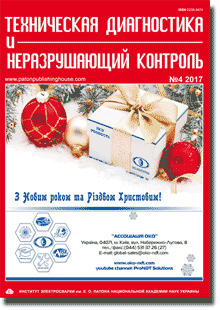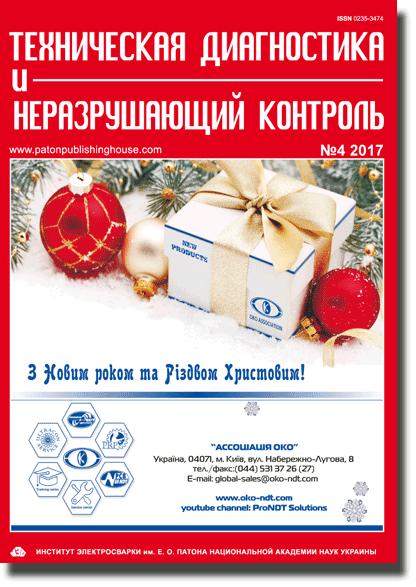| 2017 №04 (04) |
DOI of Article 10.15407/tdnk2017.04.05 |
2017 №04 (06) |

Technical Diagnostics and Non-Destructive Testing, №4, 2017 pp. 32-41
Comparison of diferent systems of magnetizing devices with constant magnets for magnetic particle testing
V. A. Troitskii, V. M. Gorbik, O. S. Borodai
E.O. Paton Electric Welding Institute of the NASU, 11 Kazimir Malevich Str., Kiev, 03150. E-mail: office@paton.kiev.ua
Typical designs of existing constant magnet magnetizing devices, used in magnetic-particle testing, are considered. The disadvantages of magnetizing devices with flexible connection of the poles by steel cable are noted and the advantages of the devices, in which this connection is made by flexible pivot magnetic core (yoke), are shown. The results of research of magnetic flows distribution in the systems with cable and interpole yoke are presented. Specifications of serially produced magnetizing devices are also given. Presented are the results of efficiency of flaw detection using magnetizing devices with pivot magnetic core. 5 Ref., 1 Tabl., 13 Fig.
Keywords: magnetic particle testing, magnetizing devices, constant magnet, magnetic flow, magnetic field, magnetic induction
References
- Troitsky, V.A. (2002) Magnetic particle testing of welded joints and machine parts. Kiev, Fenix [in Russian].
- GOST 21105-87: Non-destructive testing. Magnetic particle method [in Russian].
- DSTU EN ISO 17638:2014: Non-destructive testing of welds. Magnetic particle testing [in Russian].
- EN ISO 9934, Pt. 1,2,3: Magnetic particle testing [in Russian].
- (1980) Electrotechnical reference book. Ed. by V.G. Gerasimov. In: 3Vol. Moscow, Energiya [in Russian].
The cost of subscription/purchase order journals or individual articles
| Journal/Currency | Annual Set | 1 issue printed |
1 issue |
one article |
| TPWJ/USD | 384 $ | 32 $ | 26 $ | 13 $ |
| TPWJ/EUR | 348 € | 29 € | 24 € | 12 € |
| TPWJ/UAH | 7200 UAH | 600 UAH | 600 UAH | 280 UAH |
| AS/UAH | 1800 UAH | 300 UAH | 300 UAH | 150 UAH |
| AS/USD | 192 $ | 32 $ | 26 $ | 13 $ |
| AS/EUR | 180 € | 30 € | 25 € | 12 € |
| SEM/UAH | 1200 UAH | 300 UAH | 300 UAH | 150 UAH |
| SEM/USD | 128 $ | 32 $ | 26 $ | 13 $ |
| SEM/EUR | 120 € | 30 € | 25 € | 12 € |
| TDNK/UAH | 1200 UAH | 300 UAH | 300 UAH | 150 UAH |
| TDNK/USD | 128 $ | 32 $ | 26 $ | 13 $ |
| TDNK/EUR | 120 € | 30 € | 25 € | 15 € |
AS = «Automatic Welding» - 6 issues per year;
TPWJ = «PATON WELDING JOURNAL» - 12 issues per year;
SEM = «Electrometallurgy Today» - 4 issues per year;
TDNK = «Technical Diagnostics and Non-Destructive Testing» - 4 issues per year.





